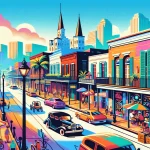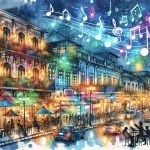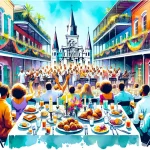Bourbon Street, the pulsating core of New Orleans’ French Quarter, stands out for its eclectic bar scene. With a storied past spanning centuries, this iconic street has evolved into a must-visit destination for those seeking an unforgettable night out. From classic cocktail lounges to lively music venues, Bourbon Street caters to every taste and preference with its variety of drinking establishments.
In This Article
TL;DR
- Bourbon Street boasts a wide variety of bars, each offering its own distinctive atmosphere and offerings.
- Live music and local culture play a significant role in shaping the experience at many Bourbon Street bars.
- Visitors should exercise caution and navigate the area responsibly, especially during the night.
Historical Significance of Bourbon Street Bars
The origins of Bourbon Street as a nightlife hotspot can be traced back to the late 19th and early 20th centuries. As the nearby Storyville red-light district gained notoriety, Bourbon Street transformed from a residential area into an entertainment district. Jazz musicians would perform in the brothels and music halls, laying the foundation for the street’s musical legacy.
Over the decades, Bourbon Street’s bar scene has evolved and adapted to changing times. During the Prohibition era, many establishments operated as speakeasies, covertly serving alcohol to thirsty patrons. When Prohibition was repealed in 1933, the bars on Bourbon Street flourished once again, attracting both locals and visitors alike.
Iconic Bourbon Street Bars
Pat O’Brien’s
Among the numerous bars that line Bourbon Street, a few stand out as true icons. Pat O’Brien’s, established in 1933, is famous for its creation of the Hurricane cocktail. This rum-based drink, served in a distinctive hurricane lamp-shaped glass, has become synonymous with New Orleans nightlife.
The Old Absinthe House
Another historic spot is The Old Absinthe House, which dates back to 1807. This bar has welcomed countless famous patrons over the years, including Mark Twain, Oscar Wilde, and Franklin Roosevelt. Visitors can immerse themselves in the bar’s rich history while sipping on classic cocktails like the Absinthe Frappe.
Lafitte’s Blacksmith Shop Bar
For those seeking a truly unique experience, Lafitte’s Blacksmith Shop Bar is a must-visit. Housed in a building that dates back to the 1700s, this bar claims to be one of the oldest in America. Its rustic, candlelit ambiance transports patrons back in time as they enjoy their drinks.
Unique Features of Bourbon Street Bars
One of the defining characteristics of Bourbon Street bars is the prevalence of live music. Many establishments feature local jazz, blues, and zydeco bands, creating a lively and authentic atmosphere. The music spills out onto the street, contributing to the area’s vibrant energy.
In addition to music, Bourbon Street bars are known for their signature drinks and local culinary offerings. From the aforementioned Hurricane to the Sazerac (the official cocktail of New Orleans), visitors can sample an array of beverages that are deeply rooted in the city’s history and culture. Some bars also serve classic New Orleans dishes like gumbo, po’ boys, and jambalaya, allowing patrons to enjoy a taste of the local cuisine.
The architecture of Bourbon Street bars is another notable feature. Many of these establishments are housed in historic buildings that showcase the French Quarter’s distinctive architectural styles, such as Creole cottages and Victorian mansions. The ornate ironwork balconies, colorful facades, and intimate courtyards add to the charm and character of these bars.
Best Practices for Experiencing Bourbon Street Bars
To make the most of your Bourbon Street bar experience, it’s important to consider the optimal times to visit. During the day, the atmosphere tends to be more laid-back, with a focus on food and casual drinks. As the sun sets, the energy level rises, and the street comes alive with music and revelry.
If you plan on bar-hopping, it’s a good idea to pace yourself and alternate between alcoholic and non-alcoholic beverages. Many bars offer a range of mocktails and other non-alcoholic options. It’s also essential to stay hydrated, especially during the hot and humid summer months.
When navigating Bourbon Street at night, it’s important to be aware of your surroundings and exercise caution. Stick to well-lit areas, avoid walking alone if possible, and keep an eye on your belongings. If you feel uncomfortable or unsafe at any point, don’t hesitate to seek assistance from bar staff or local authorities.
Cultural Impact of Bars on Local Traditions
Bourbon Street bars play a significant role in New Orleans’ cultural traditions and festivals. During Mardi Gras, the bars serve as gathering spots for revelers, offering a place to refuel and celebrate between parades. Many establishments host special events and parties throughout the Carnival season, adding to the festive atmosphere.
Beyond Mardi Gras, Bourbon Street bars contribute to the preservation and promotion of New Orleans’ rich musical heritage. By providing a platform for local musicians to showcase their talents, these bars help keep the city’s jazz, blues, and zydeco traditions alive. Some bars even host regular jam sessions, allowing aspiring musicians to hone their skills alongside seasoned professionals.
In local folklore, Bourbon Street bars are often portrayed as community centers where people from all walks of life come together to socialize, share stories, and escape the stresses of daily life. These establishments have witnessed countless memorable moments and have become an integral part of the city’s cultural fabric.
Comparisons to Other Famous Bar Scenes
While Bourbon Street is undoubtedly unique, it shares some similarities with other famous bar scenes around the world. For example, Nashville’s Music Row is known for its concentration of country music-themed bars and live music venues, much like Bourbon Street’s emphasis on jazz and blues.
However, Bourbon Street also stands in contrast to some other well-known nightlife destinations. The Las Vegas Strip, for instance, is characterized by its glitzy casinos and high-end nightclubs, which offer a more polished and commercialized experience compared to the gritty, authentic vibe of Bourbon Street.
In terms of historical pub culture, Bourbon Street bears some resemblance to European cities like Dublin and London, where centuries-old pubs serve as gathering places for locals and visitors alike. However, the sheer concentration of bars and the lively, raucous atmosphere set Bourbon Street apart from its European counterparts.
Future Trends and Sustainability
As Bourbon Street continues to evolve, many bars are embracing sustainability and eco-friendly practices. Some establishments have implemented recycling programs, switched to biodegradable straws and cups, and are sourcing ingredients from local, sustainable suppliers. These efforts not only reduce the environmental impact of the bars but also appeal to increasingly eco-conscious consumers.
Technology is also playing a role in shaping the future of the Bourbon Street bar experience. Some bars have introduced mobile ordering and payment systems, allowing customers to avoid long lines and minimize contact with staff. Others have incorporated interactive elements like touchscreen menus and digital displays to enhance the overall ambiance.
Looking ahead, it’s clear that Bourbon Street will continue to be a vital part of New Orleans’ cultural landscape. While the specific bars and trends may change over time, the street’s spirit of celebration, music, and community will endure. As long as there are thirsty patrons seeking a good time and talented musicians ready to entertain, Bourbon Street will remain a beloved destination for locals and visitors alike.






